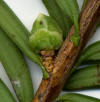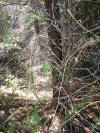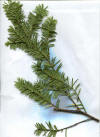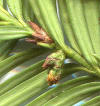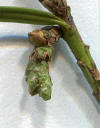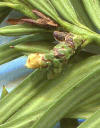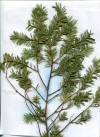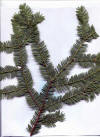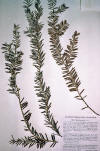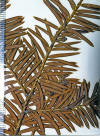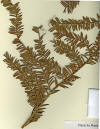3c. Taxus brevifolia var. polychaeta Spjut—J. Bot. Res. Inst. Texas 1 (1): 217. 2007. Type: U.S.A., Washington: Thurston Co., Mud Bay, near Tacoma, F. G. Meyer 1589 (holotype: K!), photo shown in key. Note: A combination attributed to Silba, Taxus brevifolia subsp. polychaeta with reference to "J. Int. Conifer Preserv. Soc. 17(1): 22. 2010" (n.v.) is inconsistent with taxonomic treatment of subtaxa within the genus (Silba 1984; Spjut 2007a, Spjut 2007b). Subspecies status in Taxus was applied to geographically differentiated populations by Pilger (1903, 1916, 1926). Thus, Silba's proposed combination is superfluous and possibly invalid. See also Ellison AM, Davis CC, Calie PJ, Naczi RFC; Pitcher plants (Sarracenia) provide a 21st-century perspective on infraspecific ranks and interspecific hybrids: A modest proposal for appropriate recognition and usage. Syst. Bot. 39: 939–949, 2014. Diagnostic features: Tree with erect trunk at base, vegetative reproduction unknown; branches developing in all directions around the trunk, wide spreading to ascending or somewhat erect; ovuliferous shoots cylindrical with numerous scales that are all similar in size (belonging to the primary shoot), the entire shoot complex much longer than seed, sometimes shortly branched near base, or branched above base (Sonoma County, CA), usually with more than one ovule, two subterminal ovules on long primary shoots , 5–8 mm long, in the northern range, or as many five ovules on branched shoot complexes <5 mm long in plants from Sonoma County, CA. Worm-cone yew: California (Mendocino Co.?, Sonoma Co.), Washington (Mud Bay near Tacoma, extirpated?). Specimens studied: California: Sonoma Co.: 7 km E of Stewarts Point, redwood-grand fir forest, 200 m, Rich Spjut & Rick Spjut 16021 (wba). Bigelow (Marin, Sonoma or Mendocino Co.), yr 1854 (US); Salmon Creek (Sonoma or Mendocino Co.?), McMurphy 315 (US). Idaho, near Coeur d'Alene, shipped by Marion Blatch as fresh material via overnight mail from Coeur d'Alene Nursery, 26 June 1992, possibly collected in nearby Washington; collector, locality, and habit of plant unknown, supplied by the USDA Forest Service without data. A report by Spjut (1977) noted a collection from “Coeur d'Alene National Forest: T51N R8W Sec. 25; 3,800 ft, on north slope near stream” (n.v.). Additional occurrence of the short shoot form found Aug 2011 in the Klamath Mountains of Southern Oregon along Thompson Creek. Taxus brevifolia var. polychaeta is distinguished from the other varieties of the species by long cylindrical fertile shoots that resemble annelid or polychaete worms, hence, the epithet, polychaeta (Spjut 2007b). The ovule bearing shoots (cones) of var. polychaeta have been distinguished by their development of multiple ovules (this web page, June 2010); however, vars. brevifolia and reptaneta have since been found to have multi-ovulate shoot complexes, but they differ in the shape of the shoot, cylindrical in var. polychaeta, funnelform in the other varieties. The ovules may appear terminal on a ovular shoot complex (var. brevifolia, polychaeta, reptaneta), or in var. polychaeta the secondary shoot may further grow from an aborted development of one of the ovules, leaving the lower ovular region to appear lateral with one or more terminal ovules, or as others have suggested, multiple secondary shoots may arise from a primary shoot over a period of several seasons (Anderson & Owens 1999; Anderson 2001). It has not been determined whether the primary shoot in var. polychaeta falls with the seed or persists. The idea of Taxus having just one terminal ovule on a shoot that arises from the axis of a leaf has generally prevailed in the literature on Taxus reproductive morphology, and because there is no clear homologue to the seed-scale-bract complex in conifers (e.g., Florin 1948, 1951; Cope 1998), Taxus is also stated to lack cones; however, the definition of cone given by Clement-Westerhof (1988) includes the “ovuliferous dwarf-shoot” as it relates to extinct conifers, and further defines bract as “a foliar appendage of the cone axis.” It should be recognized that the ovular shoot complex of Taxus consists of a primary shoot that arises in the axil of leaf and a secondary shoot that arises in the axil of a scale. The interpretation of whether cones are present or absent in Taxus may be a question of whether it is the subtending scale of the secondary shoot, or the leaf that subtends the primary shoot is the bract homologue (Miller 1988). Examples of various multi-ovulate shoots of Taxus are presented in an overview of the genus Taxus. Taxus brevifolia var. polychaeta apparently occurs with the typical variety (var. brevifolia), judging from other specimens—collected by Fred Meyer reportedly at the type locality under the same number (e.g., specimen at US)—that have typical cones, and also by Peter Baye in Sonoma County. While Spjut (2007b) had earlier questioned whether var. polychaeta has biological 'species' significance (Spjut 2007b), he also noted that unique genotypes in T. brevifolia have been recognized in relationship to other geographically differentiated genotypic populations (El- Kassaby & Yanchuk 1994), but without consideration to morphological and reproductive differences (Spjut 2007b). Two varieties of T. mairei, var. mairei and var. speciosa, which are sympatric throughout most of their range in southern China, are distinguished by their branching patterns and by their seed shape and color (Spjut 2007b), and seem to correspond to two haplotypes that occur together throughout their range (Gao et al. 2007). Taxus brevifolia var. brevifolia also occurs with var. T. brevifolia var. klamathensis (Spjut ineditus, abstract submitted, var. nov.). It may be noted that Möller et al (2013) do not accept taxonomic differences in Taxus unless they are geographically distinct, possibly because disjunct populations of a particular species or variety of Taxus may be associated with different species of Taxus at the different locations, in which there are likely to be genetic differences resulting from historical hybridization and introgression. The occurrence of var. polychaeta along the California coastal region is rare (Baye 2004, ltr to Calif. Dept. Forestry; Spjut 2007). One record cited for Sonoma County by Spjut (2007) was from Annapolis (Milo Baker s.n.). In a brief survey of this area by Rich Spjut and Rick Spjut in August 2006, we found only one tree (Rich Spjut & Rick Spjut 16021; Spjut 2007). However, additional plants have been found by Peter Baye at widely scattered spots along Fuller Creek and its north-facing drainages as noted by him in a report (letter) to the California Dept. of Forestry (www.gualalariver.org/vineyards/martin-baye.pdf; no longer available), and subsequently has found it at other locations (Peter Baye, pers. comm., Mar-June 2010), some of which have been studied by Spjut (Spjut & Baye proposed publ. on Taxus in Sonoma County). Generally, plants of var. polychaeta occur as isolated individuals at intervals of 300–500 m, or may be found in small numbers of up to three or more plants within 50 m of each other. Nonetheless, the occurrences are still considered rare, especially in view of the narrow ecological zone in which they seem to occupy (Spjut & Baye proposed publ.). Peter Baye has also found plants of var. brevifolia substantiated by a photo of arillocarpia sent to Spjut in June 2010 for confirmation. Spjut has since found var. polychaeta along Thompson Creek in Jackson Co.—in the Klamath Mountains Region of southern Oregon—in early August 2011 while conducting a survey for Veratrum californicum. Additionally one image placed on CalPhotos in 2011, reportedly taken from Opal Creek Wilderness in the Cascade Range—showing a single arillocarpium—is similar to var. polychaeta in the relatively visible primary shoot, but the shoot scales overlap only slightly, appearing fewer in number and in series, 3 or 4 seriate. Other coastal occurrences of Taxus brevifolia were reported from a ravine on Sea Ranch in southern Mendocino County, an area reportedly logged in early 1900’s and again in the early 1990’s (Web report previously cited but no longer available online, or has changed), and also one specimen provided by the participants in the California Consortium of Herbaria collected from near the town of Mendocino; ucjeps.berkeley.edu/consortium/; Fri Sep 3 14:49:50 2010; Wheeler & Gladys L. Smith 2681 (collected 29 Jul 1981), HSC83650. It was reported that the specimen with a male cone (strobilus) collected by John Milton Bigelow from California corresponded to a male plant of var. polychaeta (Spjut 2007b, also shown below). However, male plants in the general vicinity where female plants have been found of var. polychaeta appear similar to male cones of var. brevifolia, except for possibly being smaller in size. Bigelow is known to have collected in Marin, Sonoma and Mendocino Counties (CNPS, Marin Chapter, website). More field studies are needed during the spring, along with comparative DNA and morphological analyses. This may clarify whether more than one variety or species of Taxus occurs in Sonoma County.
3a. Taxus brevifolia var. brevifolia 3d. Taxus brevifolia var. klamathensis 3c. Taxus brevifolia var. reptaneta
|
